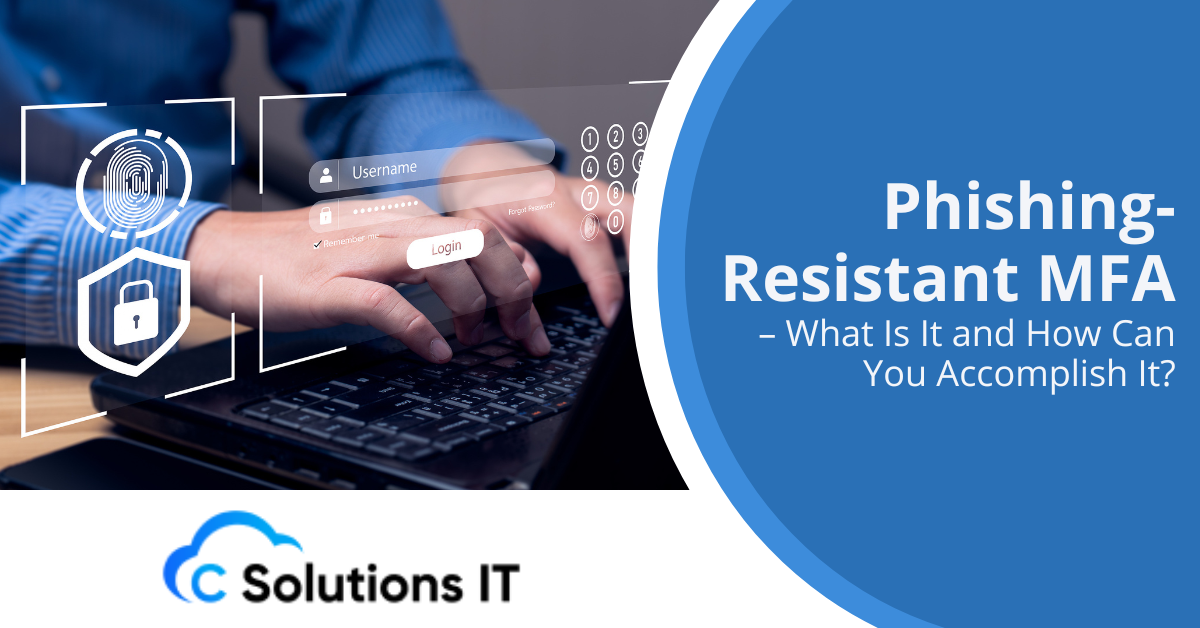Phishing-Resistant MFA – What Is It and How Can You Accomplish It?

In today’s digital landscape, the threat of cyberattacks looms larger than ever before. Phishing attacks, in particular, have become increasingly sophisticated, making it crucial for individuals and organizations to adopt robust security measures.
Multi-Factor Authentication (MFA) is a well-known and widely-used security tool. However, to truly safeguard against phishing attempts, it’s essential to implement a phishing-resistant MFA solution. In this article, we’ll delve into the concept of phishing-resistant MFA, why it’s necessary, and how you can achieve it.
Understanding Phishing Attacks
The Anatomy of a Phishing Attack
Before we dive into phishing-resistant MFA, let’s understand the mechanics of a phishing attack. A phishing attack typically involves an attacker impersonating a trustworthy entity to trick individuals into divulging sensitive information such as login credentials, credit card numbers, or personal identification. These attacks often come in the form of deceptive emails, websites, or messages.
To accomplish their nefarious goals, cybercriminals employ a range of tactics, including:
- Email Spoofing: Attackers send emails that appear to be from legitimate sources, tricking recipients into taking action.
- Fake Websites: Phishers create counterfeit websites that mimic well-known brands or organizations, luring victims to enter their data.
- Malicious Attachments: Emails or messages may contain infected attachments, which, when opened, compromise the victim’s device.
The Prevalence of Phishing Attacks
Phishing attacks have grown in frequency and sophistication over the years. According to industry reports, phishing remains one of the most common attack vectors, accounting for a significant portion of data breaches and financial losses. As cybercriminals evolve, it’s imperative that security measures evolve as well.
The Role of Multi-Factor Authentication (MFA)
What Is MFA?
Multi-Factor Authentication (MFA) is a security mechanism that requires individuals to provide two or more separate forms of identification before gaining access to a system, application, or account. The three primary factors used in MFA are:
- Something You Know: This includes passwords or PINs.
- Something You Have: This can be a mobile device or a smart card.
- Something You Are: This relates to biometric factors like fingerprints or facial recognition.
MFA significantly enhances security by adding an extra layer of protection beyond just a password. Even if an attacker manages to steal or guess a password, they would still need access to the second factor to gain entry.
Traditional MFA vs. Phishing-Resistant MFA
While traditional MFA has proven effective in many cases, it’s not immune to phishing attacks. Attackers can employ tactics like social engineering to manipulate individuals into providing the additional factors, defeating the purpose of MFA.
Phishing-resistant MFA, on the other hand, is designed to mitigate these vulnerabilities. It employs advanced techniques and technologies to ensure that even in the face of a phishing attack, the user’s identity remains secure.
Achieving Phishing-Resistant MFA
Now that we understand the need for phishing-resistant MFA, let’s explore how it can be accomplished effectively.
Biometric Authentication
The Power of Biometrics
Biometric authentication is a cornerstone of phishing-resistant MFA. Unlike traditional passwords, biometric factors are incredibly difficult to fake or replicate. Fingerprints, facial recognition, and iris scans are examples of biometric identifiers.
By incorporating biometrics into your MFA strategy, you can significantly enhance security. Even if a phishing attack successfully captures a password, the attacker would still need the user’s biometric data, which is not easily obtainable.
Behavioral Analytics
Understanding User Behavior
Behavioral analytics is another critical component of phishing-resistant MFA. This technology monitors user behavior and establishes a baseline for what is considered normal activity. Any deviations from this baseline can trigger an alert or additional authentication steps.
For example, if a user typically logs in from a specific location and suddenly attempts to access their account from a different country, behavioral analytics can detect this anomaly and prompt further authentication.
Secure Communication Channels
Protecting Data in Transit
Phishing attacks often target the communication between users and the system they are trying to access. Implementing secure communication channels, such as Transport Layer Security (TLS) or Virtual Private Networks (VPNs), ensures that data exchanged between the user and the system remains encrypted and protected from interception.
Continuous Monitoring and Updates
Staying One Step Ahead
Cybersecurity is an ever-evolving field, and attackers continually adapt their tactics. To maintain an effective phishing-resistant MFA strategy, it’s crucial to stay vigilant and keep all systems and software up to date. Regularly updating your security measures ensures that you are equipped to face new and emerging threats.
Choosing the Right Phishing-Resistant MFA Solution
With a clear understanding of the components required for a phishing-resistant MFA system, the next step is to select the right solution for your organization. Here are some factors to consider:
- Integration: Ensure that the chosen MFA solution integrates seamlessly with your existing systems and applications.
- Scalability: As your organization grows, your MFA solution should be able to scale accordingly.
- Usability: A user-friendly MFA solution is essential to encourage adoption and minimize user frustration.
- Compliance: Verify that the chosen solution complies with industry regulations and standards.
- Support and Maintenance: Consider the level of support and maintenance required to keep the solution effective.
Get Started Today
In an era where phishing attacks pose a significant threat to individuals and organizations alike, adopting phishing-resistant MFA is not an option but a necessity. By incorporating biometric authentication, behavioral analytics, secure communication channels, and continuous monitoring into your security strategy, you can significantly reduce the risk of falling victim to phishing attacks.
At C Solutions IT, we understand the critical importance of cybersecurity in today’s digital landscape. Our expertise in implementing robust MFA solutions, including phishing-resistant MFA, can help protect your organization from evolving threats. Don’t wait until you become a victim of a phishing attack; take proactive steps to secure your digital assets today. To learn more about our services, contact us and let us assist you in fortifying your cybersecurity defenses. Your security is our priority.
